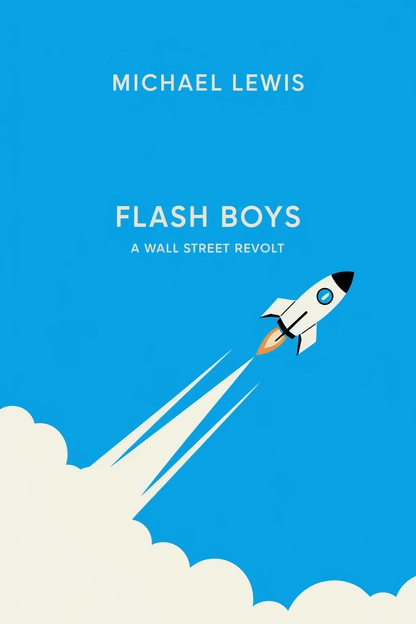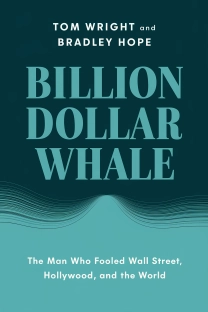
Flash Boys
A Wall Street Revolt
by Michael Lewis
Brief overview
This book unravels how certain traders use lightning-fast technology to exploit tiny delays in the stock market. By following a determined group of insiders, it reveals the hidden layers of complexity and the conflicts of interest that drive modern trading. Expect to discover how a new exchange emerged to tilt the playing field back toward fairness.
Introduction
When you hear about Wall Street, visions of frenzied traders and zooming share prices might come to mind. But beneath those flashing numbers lies a system where billionths of a second can dictate who wins and who loses. This page sets the stage for a group of people who discovered that the market wasn’t functioning as most believed. Instead of an orderly place where prices fairly reflected supply and demand, it had turned into a race for speed. The biggest takeaway is that a handful of insiders recognized how high-frequency traders were exploiting ordinary investors using ultrafast connections. Their solution was surprising: rather than beat them at their own game, they wanted to fix the rules of the game altogether.
We begin with a Canadian banker who spotted odd changes on his trading screen. Prices kept disappearing the moment he tried to complete a trade. This set him on a journey to uncover mysterious data routes, secret exchanges, and the relentless drive for microsecond advantages. The result of his curiosity reshaped the lives of many and threatened a lucrative scheme. At its heart, this is a story of how a market can veer away from its intended purpose and how a small team can steer it back.
Welcome to a book where Ethernet cables and fiber-optic lines matter more than you’d expect. Where a few bright minds noticed something off-kilter and refused to look the other way. Let’s see how it all begins.
The Speed Dilemma
Speed creeping into trading is nothing new: centuries ago, faster couriers meant timelier news about crop prices. But today, speed is defined in microseconds. Traders rent server space next to stock exchanges, coil miles of fiber-optic cables in shoe boxes, and obsess over shorter routes between cities. After the 2008 financial crisis, this race accelerated. Engineers became the new hotshots, and code replaced hand signals. The real power shifted to those who understood how to process data one heartbeat sooner than anyone else.
High-frequency trading firms weren’t just trying to be quick; they wanted a head start. Placing their servers literally a foot closer to an exchange’s main computers translated to precious extra nanoseconds. An entire industry sprang up, devoted to carving direct routes, drilling through mountains, and eliminating every imaginable delay. To everyday investors, the idea that a few milliseconds could build fortunes is perplexing. Yet in this environment, if you’re not first, you’re last. The motivations for this speed-obsessed crowd lay at the heart of the market’s distortions.
It wasn’t just independent traders pushing for faster connections. Big banks and established exchanges soon realized they could charge for privileged data and sell speed. Each new advantage for one group came at the expense of everyone else, as large stock orders were exposed and manipulated.
What is Flash Boys about?
Michael Lewis’s “Flash Boys: A Wall Street Revolt” offers a revealing look into how high-frequency traders gained an edge through exceptional connectivity and swift technology. By highlighting real-life figures, such as Brad Katsuyama, the book unveils the hidden pathways that siphon profits from everyday investors and big institutions alike. This well-researched narrative underscores how financial markets became a place where milliseconds define winners and losers.
More than an exposé, “Flash Boys” shows readers what happens when a small group sets out to change an entire market. Their work on a fair-access exchange shows that transparency and ethics can combat deeply ingrained practices. If you want to understand the mechanics behind modern trading—and why they matter to everyone from pension holders to day traders—this book lays it all out in clear, accessible detail.
Review of Flash Boys
This book’s key strength lies in its vivid storytelling combined with thorough research on the world of high-frequency trading and dark pools. Readers gain practical insights into why tiny time gaps can mean massive profit shifts, and how regulatory gray areas can threaten market fairness. Its unique value is in depicting the real individuals who took on the status quo, showing that technology can foster both inequity and innovative solutions, depending on who wields it.
Michael Lewis writes with a style that blends professional knowledge and plainspoken clarity, making dense financial concepts easy to digest. The relevance extends to anyone curious about the hidden forces that shape our global economy, including experienced financial analysts, tech-savvy readers, and everyday investors. By the end, “Flash Boys” comes with a clear recommendation: it’s a must-read for anyone seeking an honest view of Wall Street’s underpinnings and a roadmap toward fairer markets.
Who should read Flash Boys?
- Finance professionals who need to understand how high-frequency trading affects their clients
- Technology enthusiasts eager to learn how coding and connectivity power modern finance
- Everyday investors looking to protect themselves from hidden fees and predatory tactics
- Ethical business leaders striving to create fairer practices within complex markets
About the author
Book summaries like Flash Boys
Why readers love Mindleap
10-Minute Book Insights
Get the core ideas from the world's best books in just 10 minutes of reading or listening.
Curated For You
Discover your next favorite book with personalized recommendations based on your interests.
AI Book ExpertNew
Chat with our AI to help find the best book for you and your goals.
Reviews of MindLeap
Love how I can get the key ideas from books in just 15 minutes! Perfect for my busy schedule and helps me decide which books to read in full.
Alex R.
The summaries are incredibly well-written and the audio feature is perfect for my commute. Such a time-saver!
Jessica M.
Great app for personal growth. The insights are clear and actionable, and I love how they capture the essence of each book.
Chris P.
The app is beautifully designed and the summaries are top-notch. Definitely worth every penny!
Sarah K.





